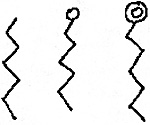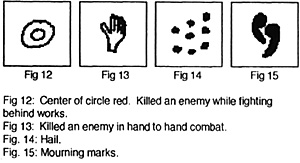
Figures 1, 2 and 3: Believed to be "good medicine" signs.
 Fig. 6 Markings placed around a horse's eye(s) in order to provide better vision
Fig. 6 Markings placed around a horse's eye(s) in order to provide better vision
I started collecting 25mm Indian Wars figures about 12 years ago. However, they really seemed to have caught on within the last several years. With this in mind, I thought I would share some of my research into painting these figures.
U.S. Army
Uniform colors consistently weren't. Pants were described as being anywhere from a deep to a pale, muddy blue. Coats were anything from gray-green to black. Now, you can have some originality among the uniformed troops!
The new uniform of 1872 was cut in a similar style to those worn in Europe at the time. The uniform transition was complete by 1874. Old clothing could still be worn in the field and this was encouraged by the Quarter Master Department.
A black campaign hat was approved for campaign wear in 1872, however the forage cap was still popular. Trouser Stripes: Corporals - 1/2 inch; Sergeants - 1 inch; Officers - 1 1/2 inch. Canteen Covers: Brownish gray to sky blue. Blankets'. Brownish gray or gray with a 3 1/2 inch wide stripe near each end. "U.S." in 4 1/2 letters stitched in black yarn in the center of the blanket. In 1876, blanket stripes and "U.S." were indigo blue instead of black.
A new uniform pattern was adopted in 1874.
In 1875, the Army decided the bugle insignia was outdated and the crossed rifles were adopted as the new branch insignia -- much to the dismay of some of the old veterans, The 1872 campaign hat was also recognized as a failure and large numbers of privately purchased hats in subdued colors were being worn instead.
In 1876, a new black campaign hat was adopted. Dark blue chevrons delineated by white stitching were authorized for wear on the infantry overcoat. The reasoning behind this uniform change was that since both the overcoat and chevrons were light blue, it was very difficult to identify the non- commissioned officers.
Indians


Fig. 4 Believed to represent the sun
Fig. 5 A yellow circle surrounded by a blue circle. Also a blue circle surrounded by a yellow circle. Believed to be another representation of the sun.
(left) Fig. 7 Lightning bolts to provide the attributes of lightning.
Ponies were painted according to individual exploits, visions and
taste. Primary colors were red and yellow. Blue and white were also used. Each
half or side of the horse told a complete story. The two halves were not added
together to make a whole story.
Shields
Protection offered by shields did not come from their physical properties, but rather from the "medicine" of the shield. Shields could be painted with the sun, stars, moon, eagle, thunderbird, bear, bear claws, buffalo, buffalo head, dragonfly, war exploits or anything else that had significance to the brave who carried the shield. Shields could also be decorated with feathers, beads, teeth, scalps, ribbons and small dead animals.
 Fig. 8: War party
Fig. 8: War party
Fig. 9: Successful
Fig. 10: Coup marks or raids or horses stolen society marks.
Body Paint
Erroneously called "war paint." Body paint was frequently red or black. However, white, yellow, green and blue were also used. It was also common to use several different colors. Other than certain societal and ceremonial markings, body paint was an individual thing and the numerous body paint patterns are beyond the scope of this work.
I hope this information has been useful to some of you. I also suggest you take a look at the western art and artist books at your local library.
 Left: Fig. 11 Participated in a battle fought behind works, such as rock formations, fallen trees, etc.
Left: Fig. 11 Participated in a battle fought behind works, such as rock formations, fallen trees, etc.
 Fig 12: Center of circle red. Killed an enemy while fighting behind works.
Fig 12: Center of circle red. Killed an enemy while fighting behind works.
Fig 13: Killed an enemy in hand to hand combat.
Fig. 14: Hail.
Fig. 15 Mourning marks.
Back to The Herald 27 Table of Contents
Back to The Herald List of Issues
Back to MagWeb Master Magazine List
© Copyright 1999 by HMGS-GL.
This article appears in MagWeb (Magazine Web) on the Internet World Wide Web. Other military history articles and gaming articles are available at http://www.magweb.com